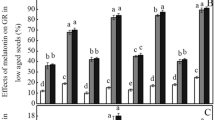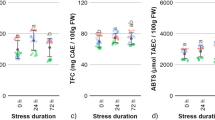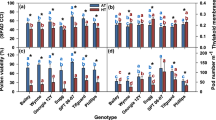Abstract
SEEDS usually exhibit their maximum germination potential soon after harvest, and as storage time increases, they lose vigour and eventually die. The rate of physiological ageing generally increases with increased moisture content and temperature1. In addition, certain xerophytic storage fungi (primarily Aspergillus spp.) can attack seeds in storage when seed moisture content is in equilibrium with relative humidities greater than 65% (ref. 1), and cause changes that mimic physiological ageing. Physiological changes accompanying physiological ageing1–5 and attack by storage fungi5 have been catalogued, but the basic biochemical events leading to these changes are not known. Harrington1 and Pammenter et al.6, however, have suggested that oxidation of unsaturated lipids may lead to free-radical formation. Free radicals may then damage cellular membranes and react destructively with macromolecules. Similar suggestions have been presented to explain ageing in several other systems7, and the results of experiments reported here indicate that free-radical formation may be important in seed deterioration. Theories of mechanisms of lipid oxidation indicate that fatty acids with two or more unsaturated bonds should be more labile and prone to form free radicals than more highly saturated acids8,9. Thus, if fatty acid oxidation and free-radical formation are occurring, the highly unsaturated acids should decrease as seeds deteriorate, whereas the quantity of saturated fats should remain constant in the absence of beta oxidation.
This is a preview of subscription content, access via your institution
Access options
Subscribe to this journal
Receive 51 print issues and online access
$199.00 per year
only $3.90 per issue
Buy this article
- Purchase on Springer Link
- Instant access to full article PDF
Prices may be subject to local taxes which are calculated during checkout
Similar content being viewed by others
References
Harrington, J. F., Seed Sci. Technol., 1, 453–461 (1973).
Ching, T. M., Seed Sci. Technol., 1, 73–88 (1973).
Roberts, E. H., Viability of Seeds (Syracuse University Press, Syracuse, New York, 1972).
Woodstock, L. W., Seed Sci. Technol., 1, 127–157 (1973).
Harman, G. E., Khan, A. A., and Tao, K. L., Can. J. Bot. (in the press).
Pammenter, N. W., Adamson, J. H., and Berjak, P., Science, 186, 1123–1124 (1974).
Marx, J. L., Science, 186, 1105–1107 (1974).
Mattick, L. R., and Hand, D. B., Agric. Food Chem., 17, 15–17 (1969).
Hoffman, G., in Symposium on Foods: Lipids and Their Oxidation (edit. by Schultz, H. W., Day, E. A., and Sinnhuber, R. O.), 215–229 (Avi. Publishing, Westport, Connecticut, 1962).
van Wijngaarden, D., Analyt. Chem., 39, 848–849 (1967).
James, A. T., in Methods of Biochemical Analysis, 8 (edit. by Glick, D.), 1–59 (Interscience, New York, 1960).
Delouche, J. C., and Caldwell, W. P., Proc. Ass. off. Seed Analysts, N. Am., 50, 124–129 (1960).
Harman, G. E., and Pfleger, F. L., Phytopathology, 64, 1339–1344 (1974).
Waller, R. A., and Duncan, D. B., J. Am. statist. Ass., 64, 1484–1503 (1969).
Author information
Authors and Affiliations
Rights and permissions
About this article
Cite this article
HARMAN, G., MATTICK, L. Association of lipid oxidation with seed ageing and death. Nature 260, 323–324 (1976). https://doi.org/10.1038/260323a0
Received:
Accepted:
Issue Date:
DOI: https://doi.org/10.1038/260323a0
This article is cited by
-
Seed dormancy and germination of a critically endangered plant, Elaeagnus mollis, on the Loess Plateau of China
European Journal of Forest Research (2021)
-
Gamma radiation and magnetic field mediated delay in effect of accelerated ageing of soybean
Journal of Food Science and Technology (2015)
-
Selection and molecular characterization of a high tocopherol accumulation rice mutant line induced by gamma irradiation
Molecular Biology Reports (2014)
-
Age-specific variation of resistance to oxidative stress in the greater flamingo (Phoenicopterus ruber roseus)
Journal of Ornithology (2010)
-
Amelioration of the effects of ageing in onion seeds by osmotic priming and associated changes in oxidative metabolism
Biologia plantarum (1994)
Comments
By submitting a comment you agree to abide by our Terms and Community Guidelines. If you find something abusive or that does not comply with our terms or guidelines please flag it as inappropriate.



